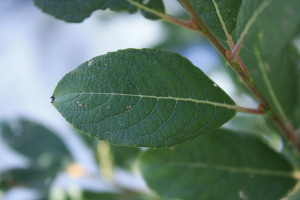Salix bebbiana
A commonly found willow naturally does well along riverbanks, swamps and marshes. Can tolerate rocky and heavy clay soil. Plant is dioecious meaning male and female are separate plants. Attracts pollinators. Important food source for pollinators early in the season.
Height : 3-25 feet
Spread : 3-20 feet
Light : Full sun to part shade
Water : Medium to wet
Soil : Sand, loam, clay
Zone : 3
Leaves : Dull, blue-green smooth texture when mature. Ovate, long shape with visible veins
Stem : Bark is gray and slightly furrowed with a diamond pattern. New shoots are a reddish-brown
Flower : Produces florets that sport yellow flowers on a catkin that emerges in mid to late spring
Fruit : Female flowers “catkins” yield seeds with white thread-like fibers that allow for wind dispersal
Habit : Multi-stemmed shrub/shrubby tree which often forms thickets
